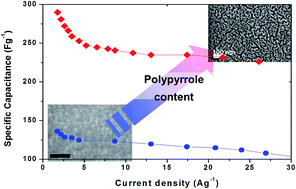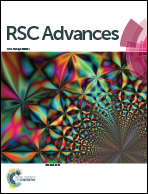Nanoscale phase separation in laponite–polypyrrole nanocomposites. Application to electrodes for energy storage†
Abstract
Nanocomposites of the smectite clay nanomaterial laponite and the conductive polymer polypyrrole are processed from aqueous solutions using dip-coating of a substrate. With increasing polypyrrole content from 2 to 20%, evidence of phase separation at the nanoscale is obtained. Based on morphology observations, polypyrrole is thought to graft on the laponite face thus serving to glue the laponite coins face-to-face with excess polymer being rejected to the interface between the laponite nanodomains. This results in interconnecting polypyrrole nanodomains that meander throughout the film thickness towards the substrate surface. This particular nanocomposite structure is explored for supercapacitor applications because of its high surface area and the interconnecting conductive polymer phase. Supercapacitor electrodes with specific capacitances of up to 360 F g−1, high retention rates and long-term durability are obtained. The main advantage of these new electrodes lies in their high materials efficiency because the clay material acts as support for the active polymer component that may be down-scaled to 10% with little of properties. Because processing can be achieved in aqueous solutions and temperatures below 100 °C are sufficient to cure the films, the electrodes are environmentally friendly and have a low carbon footprint.


 Please wait while we load your content...
Please wait while we load your content...